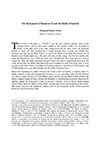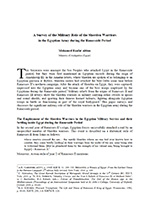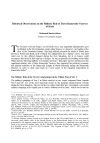Ramsès II
« The Bodyguard of Ramesses II and the Battle of Kadesh »
ENiM 9, 2016, p. 113-123.
 La Bataille de Qadech fut l’affrontement militaire le plus célèbre de l’histoire antique, avant Alexandre, et le premier conflit majeur à être décrit en détail. Ramesses II a clairement considéré la bataille de Qadech comme le sommet de son règne. Dans les descriptions de la bataille, le rôle militaire des gardes du corps de Ramesses II apparaît comme essentiel. Le roi fut sauvé grâce au courage du corps des gardes du corps, composé principalement de Chardanes, après la fuite de ses officiers et soldats aux moments les plus durs de la bataille, qui suivirent l’attaque des Hittites. Cet article analyse le rôle militaire des gardes du corps de Pharaon au cours de cette grande bataille.
La Bataille de Qadech fut l’affrontement militaire le plus célèbre de l’histoire antique, avant Alexandre, et le premier conflit majeur à être décrit en détail. Ramesses II a clairement considéré la bataille de Qadech comme le sommet de son règne. Dans les descriptions de la bataille, le rôle militaire des gardes du corps de Ramesses II apparaît comme essentiel. Le roi fut sauvé grâce au courage du corps des gardes du corps, composé principalement de Chardanes, après la fuite de ses officiers et soldats aux moments les plus durs de la bataille, qui suivirent l’attaque des Hittites. Cet article analyse le rôle militaire des gardes du corps de Pharaon au cours de cette grande bataille.
 The Battle of Kadesh was the most famous military clash in the ancient history and the first major conflict in the ancient world, before Alexander, to be described in detail. Ramesses II clearly regarded the Battle of Kadesh as the peak of his entire reign. The important military role of the bodyguard of Ramesses II was noticeable in the records of Ramesses II on the Battle of Kadesh. Ramesses II rescued in the battlefield, according to the valor of the royal bodyguard, which consisted mostly of the Sherden soldiers, after the escape of his officers and soldiers during the harsh moments of fighting that followed the Hittite attack on the lines of the Egyptian army at the beginning of the battle. This paper discusses the significant military role of the bodyguard of the warrior pharaoh Ramesses II in this great battle
The Battle of Kadesh was the most famous military clash in the ancient history and the first major conflict in the ancient world, before Alexander, to be described in detail. Ramesses II clearly regarded the Battle of Kadesh as the peak of his entire reign. The important military role of the bodyguard of Ramesses II was noticeable in the records of Ramesses II on the Battle of Kadesh. Ramesses II rescued in the battlefield, according to the valor of the royal bodyguard, which consisted mostly of the Sherden soldiers, after the escape of his officers and soldiers during the harsh moments of fighting that followed the Hittite attack on the lines of the Egyptian army at the beginning of the battle. This paper discusses the significant military role of the bodyguard of the warrior pharaoh Ramesses II in this great battle
 Consulter cet article (42181) -
Consulter cet article (42181) -  Télécharger cet article au format pdf (22932)
Télécharger cet article au format pdf (22932)
« A Survey of the Military Role of the Sherden Warriors in the Egyptian Army during the Ramesside Period »
ENiM 10, 2017, p. 7-23.
 Les Chardanes faisaient partie des Peuples de la mer qui attaquèrent l’Égypte pendant la période ramesside. Les pillards chardanes étaient des ennemis de l’Égypte au début du règne de Ramsès II, qui proclama sa victoire sur eux. Après leur défaite, beaucoup d’entre eux furent capturés et intégrés dans l’armée égyptienne, devenant l’une des meilleures troupes d’auxiliaires étrangers. Ils furent employés par les Égyptiens pendant toute la période ramesside. Ils servirent comme unités d’infanterie ou comme gardes du corps du roi. Les célèbres reliefs décrivant la bataille de Qadech et la bataille de Dapour au temps de Ramsès II, la guerre libyenne de Mérenptah, ou les guerres libyennes et du nord de Ramsès III, mentionnent la présence significative des unités chardanes dans l’armée égyptienne. Cet article examine et discute le rôle des guerriers chardanes dans l’armée égyptienne pendant la période ramesside.
Les Chardanes faisaient partie des Peuples de la mer qui attaquèrent l’Égypte pendant la période ramesside. Les pillards chardanes étaient des ennemis de l’Égypte au début du règne de Ramsès II, qui proclama sa victoire sur eux. Après leur défaite, beaucoup d’entre eux furent capturés et intégrés dans l’armée égyptienne, devenant l’une des meilleures troupes d’auxiliaires étrangers. Ils furent employés par les Égyptiens pendant toute la période ramesside. Ils servirent comme unités d’infanterie ou comme gardes du corps du roi. Les célèbres reliefs décrivant la bataille de Qadech et la bataille de Dapour au temps de Ramsès II, la guerre libyenne de Mérenptah, ou les guerres libyennes et du nord de Ramsès III, mentionnent la présence significative des unités chardanes dans l’armée égyptienne. Cet article examine et discute le rôle des guerriers chardanes dans l’armée égyptienne pendant la période ramesside.
 The Sherden were a part of Sea Peoples who attacked Egypt during the Ramesside period. The Sherden raiders were enemies of Egypt at the beginning of the reign of Ramesses II, who proclaimed its victory on them. After their defeat, many of them were captured and integrated into the Egyptian army, becoming one of the best troops of foreign auxiliaries. They were used by Egyptians during all the Ramesside period. They served as units of infantry or as bodyguards of the king. The famous reliefs describing the battle of Qadech and the battle of Dapour in the time of Ramesses II, the Libyan war of Merenptah, and the Libyan and northern wars of Ramesses III, refer to the significant presence of the Sherden units in the Egyptian army. This paper surveys and discusses the military role of Sherden warriors in the Egyptian army during the Ramesside period.
The Sherden were a part of Sea Peoples who attacked Egypt during the Ramesside period. The Sherden raiders were enemies of Egypt at the beginning of the reign of Ramesses II, who proclaimed its victory on them. After their defeat, many of them were captured and integrated into the Egyptian army, becoming one of the best troops of foreign auxiliaries. They were used by Egyptians during all the Ramesside period. They served as units of infantry or as bodyguards of the king. The famous reliefs describing the battle of Qadech and the battle of Dapour in the time of Ramesses II, the Libyan war of Merenptah, and the Libyan and northern wars of Ramesses III, refer to the significant presence of the Sherden units in the Egyptian army. This paper surveys and discusses the military role of Sherden warriors in the Egyptian army during the Ramesside period.
 Consulter cet article (53108) -
Consulter cet article (53108) -  Télécharger cet article au format pdf (21678)
Télécharger cet article au format pdf (21678)
« Historical Observations on the Military Role of Three Ramesside Viceroys of Kush »
ENiM 11, 2018, p. 33-40.
 Le Vice-roi de Koush (Fils royal de Koush) était un haut fonctionnaire de l’administration impériale égyptienne durant le Nouvel Empire. Les sources textuelles et archéologiques de la période ramesside indiquent que certains vice-rois ramessides ont joué un rôle militaire important durant les règnes de Séthy Ier, Ramsès II et Mérenptah, en maintenant l’autorité politique, économique et militaire de l’Empire ramesside dans ses territoires méridionaux. Ils participèrent aux grandes campagnes militaires ramessides contre la Nubie sous le commandement de leurs rois guerriers afin d’anéantir les révoltes nubiennes dans les régions d’Irem ou de Ouaouat. Ils menèrent également d’autres campagnes par eux-mêmes dans le même but ainsi qu’à des fins politiques ou économiques. Cet article examine et discute ce point afin de mettre en lumière un nouvel aspect de l’impérialisme égyptien en Nubie ramesside.
Le Vice-roi de Koush (Fils royal de Koush) était un haut fonctionnaire de l’administration impériale égyptienne durant le Nouvel Empire. Les sources textuelles et archéologiques de la période ramesside indiquent que certains vice-rois ramessides ont joué un rôle militaire important durant les règnes de Séthy Ier, Ramsès II et Mérenptah, en maintenant l’autorité politique, économique et militaire de l’Empire ramesside dans ses territoires méridionaux. Ils participèrent aux grandes campagnes militaires ramessides contre la Nubie sous le commandement de leurs rois guerriers afin d’anéantir les révoltes nubiennes dans les régions d’Irem ou de Ouaouat. Ils menèrent également d’autres campagnes par eux-mêmes dans le même but ainsi qu’à des fins politiques ou économiques. Cet article examine et discute ce point afin de mettre en lumière un nouvel aspect de l’impérialisme égyptien en Nubie ramesside.
 The Viceroy of Kush (King’s son of Kush) was a high official in the structure of the Egyptian imperial administration during the New Kingdom. The textual and archaeological evidence of the Ramesside Period indicate that some Ramesside viceroys had played a significant military role during the reigns of Sety I, Ramesses II and Merenptah, to support the political, economic and military authority of the Ramesside Empire in its southern territories. They had participated in the major Ramesside military campaigns against Nubia under the command of their warrior kings that aimed to crush any Nubian revolts in the regions of Irem or Wawat. They had also led other campaigns by themselves for the same purpose and for any other political or economic purposes. This paper surveys and discusses this point, in order to shed some light on a new aspect of the Egyptian imperialism in Ramesside Nubia.
The Viceroy of Kush (King’s son of Kush) was a high official in the structure of the Egyptian imperial administration during the New Kingdom. The textual and archaeological evidence of the Ramesside Period indicate that some Ramesside viceroys had played a significant military role during the reigns of Sety I, Ramesses II and Merenptah, to support the political, economic and military authority of the Ramesside Empire in its southern territories. They had participated in the major Ramesside military campaigns against Nubia under the command of their warrior kings that aimed to crush any Nubian revolts in the regions of Irem or Wawat. They had also led other campaigns by themselves for the same purpose and for any other political or economic purposes. This paper surveys and discusses this point, in order to shed some light on a new aspect of the Egyptian imperialism in Ramesside Nubia.
 Consulter cet article (36736) -
Consulter cet article (36736) -  Télécharger cet article au format pdf (20161)
Télécharger cet article au format pdf (20161)
ENiM 18 - 2025
4 article(s) - 11 mars 2025.
ENiM 1 à 18 (2008-2025) : 223 articles
4 019 377 téléchargements
8 332 015 consulations.
Index des auteurs

Mots clés

Derniers articles : 
Robert Steven Bianchi
Duplication and Continuity
(ENiM 18, p. 13-36 — 11 mars 2025) 
Frédéric Mougenot
Rénénoutet à la porte de la maison
(ENiM 18, p. 1-12 — 29 janvier 2025) 
CENiM - Mise en ligne des volumes Ă©puisĂ©s : 
 Anne-Sophie von BOMHARD DĂ©cans Ă©gyptiens, CENiM 23, Montpellier, 2020 — (2020)
Anne-Sophie von BOMHARD DĂ©cans Ă©gyptiens, CENiM 23, Montpellier, 2020 — (2020) 
 Jean-Claude Grenier L'Osiris ANTINOOS, CENiM 1, Montpellier, 2008 — (26 dĂ©cembre 2008)
Jean-Claude Grenier L'Osiris ANTINOOS, CENiM 1, Montpellier, 2008 — (26 dĂ©cembre 2008) 
TDENiM - Mise en ligne des volumes Ă©puisĂ©s : 
 Twitter
Twitter 3615136 visites - 4256 visite(s) aujourd’hui - 106 connecté(s)
© ENiM - Une revue d’égyptologie sur internet
Équipe Égypte Nilotique et Méditerranéenne - UMR 5140 - « Archéologie des Sociétés Méditerranéennes » (Cnrs) - Université Paul Valéry - Montpellier III
























 Contact
Contact
 Abonnez-vous !
Abonnez-vous ! Équipe Égypte Nilotique et Méditerranéenne
Équipe Égypte Nilotique et Méditerranéenne UMR 5140 « Archéologie des Sociétés Méditerranéennes » (Cnrs)
UMR 5140 « Archéologie des Sociétés Méditerranéennes » (Cnrs) Université Paul Valéry - Montpellier III
Université Paul Valéry - Montpellier III